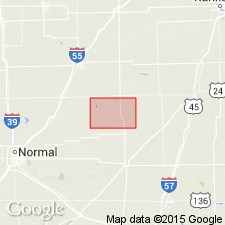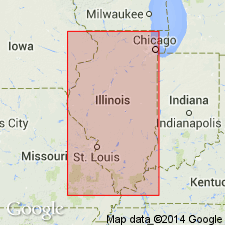
- Usage in publication:
-
- Ashmore member
- Modifications:
-
- Areal extent
- Dominant lithology:
-
- Sand
- Gravel
- Silt
- AAPG geologic province:
-
- Illinois basin
Summary:
Ashmore member of Wedron Formation. In Livingston County, Illinois, the Wedron Formation is divided into (ascending) Ashmore member, Tiskilwa Till Member, Batestown Till Member and Snider Till Member. The sand and gravel with interbedded silt at the base of the Wedron, mapped by Kempton and others (1981), is here informally called the Ashmore member. It overlies the Robein Silt, or where the Robein is absent, the Glasford Formation. Through most of the area, the top of the Ashmore lies within 50 feet of the land surface. Unit is present over most of southeastern Livingston County in thicknesses ranging from less than 1 foot to as much as 15 feet.
Source: Modified from GNU records (USGS DDS-6; Reston GNULEX).

- Usage in publication:
-
- Ashmore Tongue*
- Modifications:
-
- Principal reference
- Revised
- Dominant lithology:
-
- Sand
- Gravel
- AAPG geologic province:
-
- Illinois basin
- Wisconsin arch
Summary:
Pg. 17 (fig. 9), 18, 27 (fig. 12), 29-30, 32 (figs. 15, 17), 58-59, 101, 104, 111. Ashmore Tongue of Henry Formation of Mason Group. Restricted from Ford's 1973 (Surficial deposits of Coles Co., IL, Illinois Geol. Survey Open File Rpt.) definition to include only the medium- to coarse-grained, stratified sediment (mostly sand and gravel). (The fine-grained sediment is reallocated to the Peddicord Tongue of Equality Formation.) Thickness up to 33 feet (10 m). Is a discontinuous unit in subsurface of central and northern Illinois, and where present, is an important sand and gravel resource and productive aquifer. Underlies Tiskilwa Formation of Wedron Group. Overlies and/or interfingers with other units of Mason Group (Equality Formation, Peoria Silt, Roxana Silt). Correlates with lower part of Tiskilwa Member of Zenda Formation of Wisconsin, and part of Atherton Formation of Indiana. Interpreted to be of glaciofluvial origin. Age is Pleistocene (Wisconsinan Age; Woodfordian Subage), based on radiocarbon dating.
Type section: Charleston section, in Charleston stone quarry pits, on both sides of Embarras Valley, about 5 mi (8 km) east-northeast of Charleston, in SW/4 NW/4 sec. 5, T. 12 N., R. 10 E., Ashmore 7.5-min quadrangle, Coles Co., east-central IL. Named from village of Ashmore, Coles Co., east-central IL.
Principal reference section: Wedron section, in highwalls of pits in Wedron Silica Company quarries, in secs. 8, 9, 10, and 16, T. 34 N., R. 4 E., Wedron 7.5-min quadrangle, La Salle Co., IL.
J. Ford (Surficial deposits of Coles Co., IL, Illinois State Geol. Survey Open File Rpt., 73 p., 1973) informally proposed the name Ashmore for basal member of Wedron Formation.
Source: Publication.
For more information, please contact Nancy Stamm, Geologic Names Committee Secretary.
Asterisk (*) indicates published by U.S. Geological Survey authors.
"No current usage" (†) implies that a name has been abandoned or has fallen into disuse. Former usage and, if known, replacement name given in parentheses ( ).
Slash (/) indicates name conflicts with nomenclatural guidelines (CSN, 1933; ACSN, 1961, 1970; NACSN, 1983, 2005, 2021). May be explained within brackets ([ ]).

